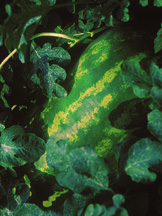 Purdue News
Purdue News
 Purdue News
Purdue News

|
|
August 2000 Changing of the gourd:
|

|
Daniel Egel, a pest management specialist at the Southwest-Purdue Agricultural Center, said a watermelon's appearance and feel are better gauges than the time-honored practice of tapping on the outer skin. Egel formerly worked for a watermelon seed company as a plant pathologist.
"There are some things I look for when I go to the supermarket or roadside stand," Egel said. "With me, I downplay 'thumping' the watermelon. In the field they don't stop to thump the watermelons, they just look at them."
The watermelon rind often provides clues to its ripeness, Egel said.
"A watermelon that is ripe will be faded on the top. If the watermelon has stripes, look at the area between the stripes. This area should be a light green," he said.
"Turn the watermelon over and look at the place where the fruit stood on the ground. If the watermelon is ripe, the 'belly spot' will be white or yellow. If you can see the stripes through the belly spot, it may not be ripe."
A smooth rind usually indicates a good fruit. "You might try to avoid melons that are over-lumpy," Egel said. "Sometimes that may mean the rind on the inside is discolored, which is unappealing to some people."
Watermelons at the peak of ripeness are normally filled out and blunt on the ends. Melons with pointy ends may still be maturing and not as delicious, Egel said.
Consumers who still want to thump the watermelon should listen closely when their finger flicks the fruit. "An unripe watermelon will 'ping' when thumped. An overripe watermelon will 'thud.' The one you want to buy is somewhere in between," Egel said.
Egel also recommended checking the watermelon for a shipper's or grower's sticker. "Remember the name on the sticker so that you can buy another of the same brand or avoid it, depending on your experience," he said.
Most watermelons sold earlier this summer were grown in Georgia or South Carolina, Egel said. But with severe drought having set in across the South, supplies may soon run out.
Midwest-grown watermelons should be arriving in grocery stores now. Producers planted a little earlier than usual this year and, with the exception of some melons damaged by soil-borne diseases, the crop appears in good shape, Egel said.
Watermelon lovers who don't mind waiting longer for their fix still have time to plant their own. "Depending on the variety, 80 to 90 days is a good growing season for a watermelon," Egel said.
Gardeners can tell when a watermelon is ready by checking the tendril, or curl, that connects the melon to the vine. "If it's still green, the watermelon is very likely not ripe. If it is brown and dead, the fruit may be ripe," Egel said.
Source: Daniel Egel, (812) 886-0198; egel@purdue.edu
Writer: Steve Leer, (765) 494-8415; sleer@aes.purdue.edu
Purdue News Service: (765) 494-2096; purduenews@purdue.edu
Related Web site:
National Watermelon Promotion Board
PHOTO CAPTION
A watermelon's color, shape and feel all are clues to its ripeness, says Dan Egel, a Purdue University pest management specialist at the Southwest-Purdue Agricultural Center in Vincennes, Ind. A ripe watermelon should be faded on top with a white or yellow belly spot, blunt on the ends and smooth to the touch. (Purdue Agricultural Communication Service photo.)
 To the Purdue News and Photos Page
To the Purdue News and Photos Page